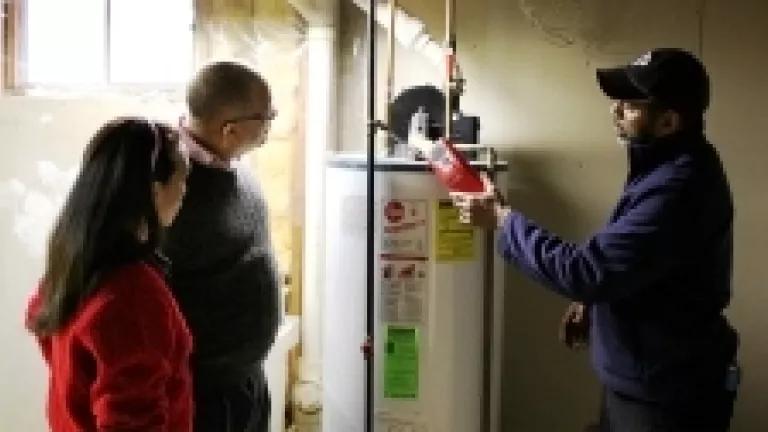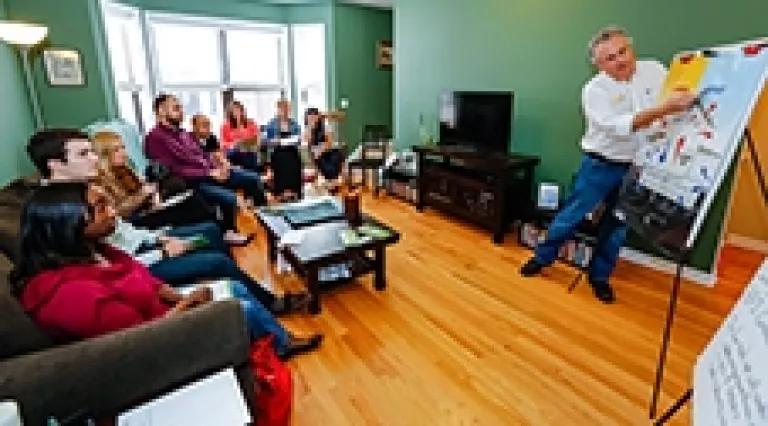
The Department of Energy's detailed warts-and-all evaluation of its $500 million stimulus-funded Better Buildings Neighborhood Program (BBNP) - an innovative initiative to explore the potential for new marketing strategies and program designs to encourage building energy upgrades that result in significant energy savings and economic stimulus - shows that comprehensive efficiency programs can be successful if they overcome the reluctance of homeowners and others whose participation is needed at the local level.
The four-year program, which leveraged multiple funding sources including private capital in addition to the American Recovery and Reinvestment Act of 2009 (ARRA) funding, supported energy efficiency improvements in almost 120,000 homes and buildings in communities nationwide. This evaluation verified that, on average, participating single family residential homes saved 15% of total energy use. Along with cutting energy bills and improving the comfort of the buildings, the program's objectives were to expand the building energy improvement industry, test program delivery models and marketing techniques, and to create jobs.
There are several very candid takeaways in the six-volume evaluation released last week, including:
- Significantly improving the efficiency of America's existing buildings, primarily residential homes and apartments in this study, will take time because "comprehensive" upgrades that include multiple efficiency measures in one go are not an easy sell for many building owners.
- Government incentives will likely be needed on a continuing basis due to the complexity of these programs, the need for educating building owners, and the importance of contractor skills training to provide these services.
- Successful programs require local buy-in and support, and perform better when there are staff involved with long-term experience with energy efficiency
A fourth and equally important takeaway is:
- Improving America's existing buildings, resulting in lower energy bills and a more livable planet, is imminently doable provided there is enough enthusiasm, money, and patience by all the partners involved.
By way of background, in 2010 DOE funded BBNP with $508 million that was competitively granted to 41 state and local governments and their partners who proposed creative approaches to community-based programs for comprehensive energy-saving building upgrades. A comprehensive upgrade might include a new furnace, sealing leaky ducts, attic and floor insulation, and super-efficient light bulbs, for example.
Some of these grantees had little experience with running energy efficiency programs, but they did have innovative ideas for how to make comprehensive upgrades more appealing - for example, by working through trusted local groups, running door-to-door neighborhood "sweep" campaigns, offering attractive financing, using creative messaging strategies (see an ad from the Denver program below!), or by structuring program incentives to encourage deeper levels of energy savings.

The objective of BBNP was to experiment with new ideas to identify the best ways to bring energy efficiency to the street and convince building owners and operators they could save enough on their utility bills to make the upgrades worthwhile. The evaluation concluded the BBNP efforts were generally successful, but also identified some issues.
Positives: By 2014, BBNP-backed projects met most of the program's original objectives, including upgrading almost 120,000 homes and buildings, and saving $850 million in energy costs. Program partners spurred $1.3 billion in economic activity related to the upgrades; created more than 10,000 full-time equivalent jobs; and generated more than $120 million in federal, state, and local tax revenues.
Concerns: There was some difficulty getting building contractors to go through the necessary training to participate in the program, and then follow up with marketing efforts to sell their new skills in their communities. While those contractors who did market themselves appear to have been successful, the report found little inclination among their competitors to join in - thus failing to create wider enthusiasm for building retrofits. Also, despite the focus of BBNP on deep energy savings, programs that offered participants more flexibility and fewer requirements were able to attract far more participants, even though the savings per building might be less.

Other important findings
The report did find evidence that BBNP's presence in a community resulted in: increased activity in the energy efficiency upgrade market; increased adoption of energy efficient building and business practices, as well as sales of energy efficient equipment; increased marketing of energy efficiency; increased availability of financing; and higher levels of consumer awareness.
The report suggests that future comprehensive efficiency programs can take a number of actions to be more successful:
- Skilled and engaged contractors are vital to success - programs should develop a large pool of eligible contractors by providing more training, and should support these contractors as the primary salesforce for the program.
- Have at least one highly experienced staff person involved in the local initiative.
- Offer incentives of up to 25 percent of the total cost of the building upgrades, and offer financing as part of any energy upgrade.
- For marketing purposes, programs and contractors should target specific populations for upgrades, but without closing out others who may be interested.
- Work through well-selected, local community-based organizations to reach their target markets.
- Work with building owners who want to stage their upgrades over time, and provide quality assurance that upgrades meet their efficiency objectives.
It's important to note the evaluators indicate many of the challenges in the BBNP-funded programs were self-correcting. They observe that half of the grantees were "starting from scratch," designing and implementing programs in areas where no related program or pilot of this type had been offered. Also, more than a third of grantees stated that their most senior staff in each of the areas of program design, implementation, green building trades, and financial institution involvement initially had less than four years of experience - relative newcomers to energy efficiency program administration.
While the grant-making phase of BBNP is complete, over 80 percent of the grantees reported that their programs, or elements of them, will continue after the end of the grant period. BBNP also contributes a rich body of experimentation with success stories, pitfalls, and lessons learned posted on the Better Buildings Residential Program Solution Center that will inform energy efficiency program designers going forward. That knowledge will be powerful in inspiring smarter energy use and charting a future where we need to generate less energy from polluting fossil fuel-fired power plants - which benefits us all.

